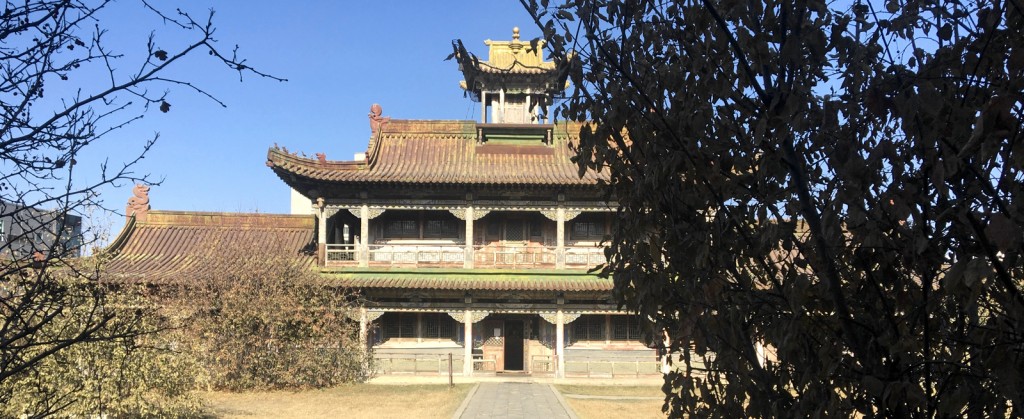
October 16, 2019
Inka had pointed out Bogd Khan’s Winter Palace the day before as we drove out of the city, and she said it was well worth a visit. Bogd Khan, Mongolia’s last emperor, ruled off and on in the early 20th century until his death in 1924. The palace is only three kilometers from my hotel, so an easy walk. That made it a no brainer for today’s itinerary. A chance to see a real Mongolian palace? You bet!
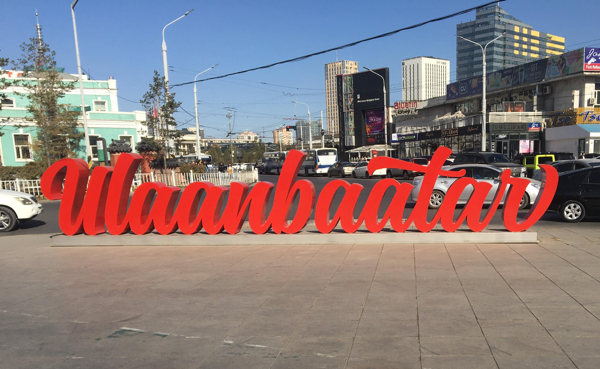 I packed my sling bag with cameras, my selfie stick, an apple, and a bottle of water, and headed out shortly before 10:00 a.m. The tourist information office was just a short walk out of my way, so I swung by to ask about shows in the area. The attendant suggested I attend one of the 6:00 p.m. shows at the Children’s Palace, which is not far from my hotel. He said the shows run about two hours and feature Mongolian traditional dancing, singing, and theater. People have said the shows were fabulous, and tickets were only about US$10.
I packed my sling bag with cameras, my selfie stick, an apple, and a bottle of water, and headed out shortly before 10:00 a.m. The tourist information office was just a short walk out of my way, so I swung by to ask about shows in the area. The attendant suggested I attend one of the 6:00 p.m. shows at the Children’s Palace, which is not far from my hotel. He said the shows run about two hours and feature Mongolian traditional dancing, singing, and theater. People have said the shows were fabulous, and tickets were only about US$10.
Sounds like a plan! I thanked him for the information, and was on my way to the last emperor’s winter palace.
It seemed like a much longer walk than three kilometers. I’m used to running three kilometers as a warm-up training run, but this walk just seemed to drag on and on. I kept checking the GPS on my phone. Are we there yet? Are we there yet? I walked past both the National Library of Mongolia and the Children’s Palace on the way, as well as crossed over Dund Gol River on the Peace Bridge.
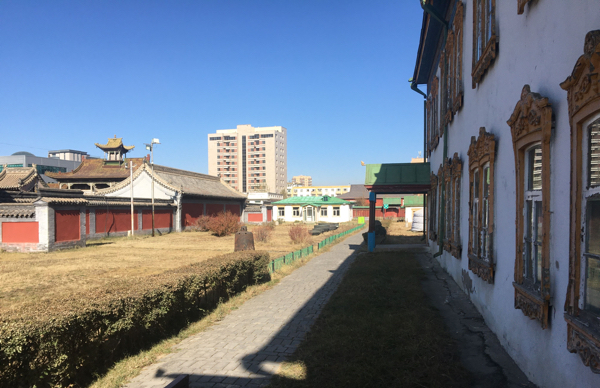 Finally, I reached the palace. The security guard pointed me to the door, and I went in the souvenir shop to ask about admission fees. It was ₮8,000 (US$3.00), four times more than admissions fees I’d paid at other sites, but still cheap by most standards. I paid the fee and walked over to the winter palace.
Finally, I reached the palace. The security guard pointed me to the door, and I went in the souvenir shop to ask about admission fees. It was ₮8,000 (US$3.00), four times more than admissions fees I’d paid at other sites, but still cheap by most standards. I paid the fee and walked over to the winter palace.
By palace standards, it is very small, about the size of an average American house. Just two stories, with maybe a dozen small rooms. The exterior was rather dilapidated and badly in need of repair and a new paint job. The interior was even worse as the ceilings showed signs of water damage. It made me sad to see one of Mongolia’s national treasures in such sorry condition.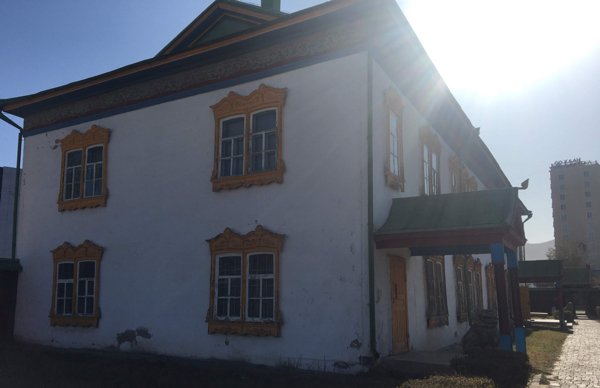
But, it had nice displays of Bogd Khan’s belongings. I pulled out my phone to take a photo of the Khan’s carriage when an attendant stopped me. No photos inside; I could only take photos outside. I thanked the attendant, put my phone away, and continued my tour of the palace. It contained furniture used by the emperor and his wife, the emperor’s childhood toys, and other items from their time. It also contained a donation jar that stated money collected was for the restoration of the palace, which made me happy. I read online later that the temple buildings have undergone a series of restoration projects since 2002, so clearly, there is a movement underway to save the palace and surrounding buildings.
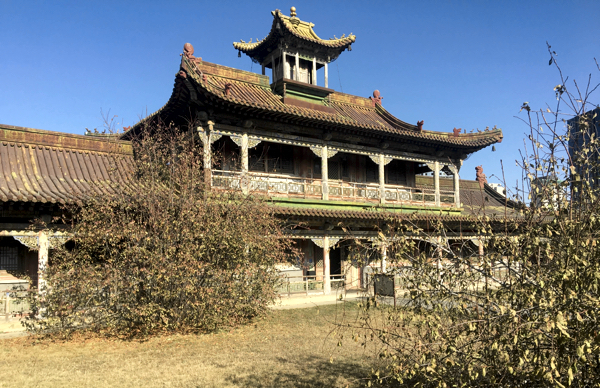 It didn’t take too long to go through the palace. I wandered the grounds outside, taking some photos. I found a door in a brick wall and entered the area of the grounds that contained the emperor’s temple, library, and other buildings. They were very ornate, similar to the Ariyaval Buddhist Meditation Temple I’d visited yesterday. And, as the palace, badly in need of more restoration.
It didn’t take too long to go through the palace. I wandered the grounds outside, taking some photos. I found a door in a brick wall and entered the area of the grounds that contained the emperor’s temple, library, and other buildings. They were very ornate, similar to the Ariyaval Buddhist Meditation Temple I’d visited yesterday. And, as the palace, badly in need of more restoration.
I explored the buildings. There were seven, each a temple, and each had a sign in front of it, in Mongolian, as well as English, explaining its purpose. The Labrang Temple was where the emperor’s main temple of prayer and worship, and where he carried out his meditations in the summer. The Library Temple contained the sutras and books. 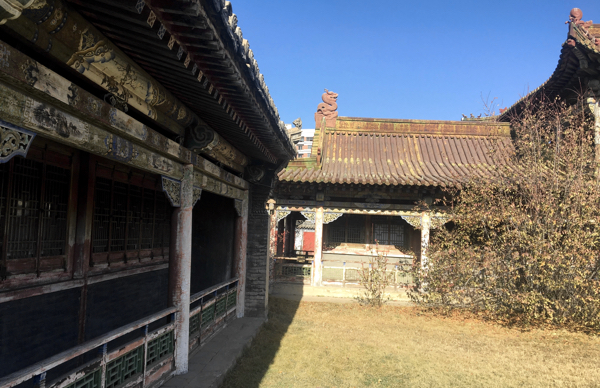 The Temple of Many Deities, referred to as the “Treasury of Idols” Temple during the Khan’s rule, houses Buddhist idols created by numerous artists using a variety of mediums.
The Temple of Many Deities, referred to as the “Treasury of Idols” Temple during the Khan’s rule, houses Buddhist idols created by numerous artists using a variety of mediums.
The temples were grouped symmetrically around two courtyards and contained more of the emperor’s artifacts, including dozens or perhaps a hundred statues of gods. The statues were everywhere. I took some video of the exterior of the buildings with my phone, and then switched to one of my video cameras when my battery ran low.
I was walking around the grounds with my video camera attached to my selfie stick when the security guard came running after me. I tried to explain to him that I had only been using my cameras outside the buildings, rather than inside, but he insisted on escorting me out, anyway.
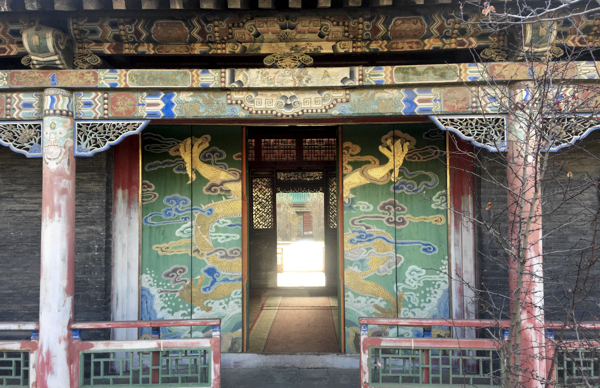 Oh, well! Somewhere along the line there had been a miscommunication. Whether it had been on the part of the museum attendant or the security guard, I don’t know. The signs said only that there was no photography allowed inside the buildings.
Oh, well! Somewhere along the line there had been a miscommunication. Whether it had been on the part of the museum attendant or the security guard, I don’t know. The signs said only that there was no photography allowed inside the buildings.
In any event, I was ready to leave, so I complied with the guard’s request and followed him out. He didn’t try to take my cameras or ask me to delete my videos or photos, so all was cool. But, I would have deleted them if he had asked.
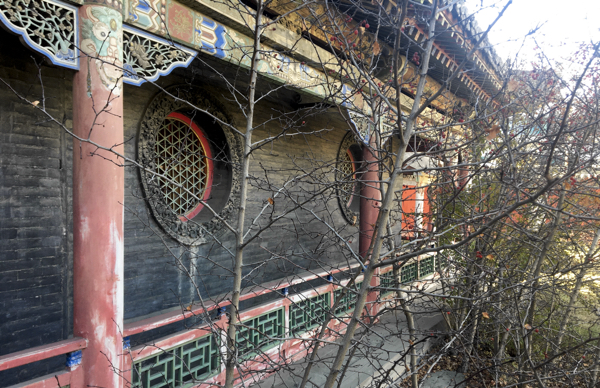 I think the visit was worth the money, and I hope the palace and temples are restored to their former glory.
I think the visit was worth the money, and I hope the palace and temples are restored to their former glory.
Curiously, the walk back seemed to take no time at all, even though I stopped at one point to video a children’s park. The park was a wonderful little oasis with grass and trees and iron animal statues the children could climb on, and it was full of families.
Before heading back to the hotel, however, I swung by Modern Nomads again for lunch. This time, I ordered a plate of lamb entrails and potatoes, along with a banana caramel milkshake. I know lamb entrails sounds weird, but it was absolutely delicious, as was the milkshake.
The total bill came to just ₮13,900, or US$5.20.
